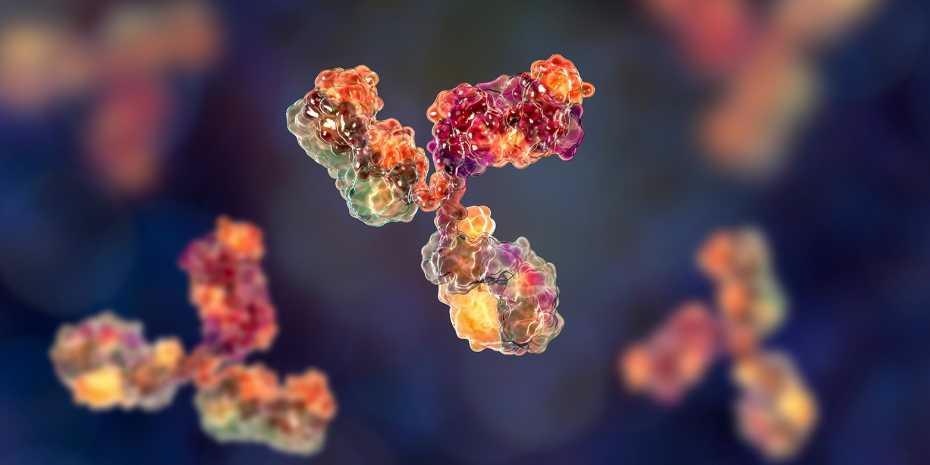Apr 16 2021
The immune cells in human beings produce antibodies that fight more than just viruses and other microbes in the body.
 Antibodies are being used as drugs. Image Credit: Shutterstock.
Antibodies are being used as drugs. Image Credit: Shutterstock.
Now for several years, antibodies generated by biotechnology are also being used by the medical field as a form of drugs. The reason for this is that antibodies have an excellent ability to attach particularly to molecular structures in accordance with the lock-and-key principle.
Such antibodies are used in many fields, such as oncology and for treating neurodegenerative conditions and autoimmune diseases.
But it is not easy to develop these antibody drugs. The fundamental requirement is that an antibody should be able to attach to its target molecule in the best possible way.
Besides this, an antibody drug should meet a range of additional criteria. For instance, it should be efficient to create through biotechnology, it should not stimulate an immune reaction in the body, and it should continue to remain stable over an extended period.
Once researchers have identified an antibody that attaches to the required molecular target structure, the process of development is far from over. Instead, it represents the beginning of a phase where scientists apply bioengineering in an attempt to enhance the properties of the antibody.
A research team headed by Sai Reddy, a professor from the Department of Biosystems Science and Engineering at ETH Zurich based in Basel, has now designed a machine learning technique that supports this optimization phase and can help design antibody drugs that are more effective.
Robots Can’t Manage More Than a Few Thousand
When an entire antibody molecule is optimized in its therapeutic form (that is, not just an antibody fragment), it used to start with an antibody lead candidate that attaches reasonably well to the required target structure.
Then by arbitrarily mutating the gene that carries the blueprint for the antibody, scientists create a few thousand corresponding antibody candidates in laboratory settings. The following step is to search among these antibody candidates to identify the ones that optimally attach to the target structure.
With automated processes, you can test a few thousand therapeutic candidates in a lab. But it is not really feasible to screen any more than that.
Sai Reddy, Professor, Department of Biosystems Science and Engineering, ETH Zurich
The best dozen antibodies from this screening process generally move on to the subsequent step and these are subsequently tested to find out how well they fulfill the additional criteria.
“Ultimately, this approach lets you identify the best antibody from a group of a few thousand,” added Reddy.
Candidate Pool Increased by Machine Learning
At present, Reddy and his collaborators are using the machine learning technique to boost the preliminary set of antibodies to be validated to several million.
The more candidates there are to choose from, the greater the chance of finding one that really meets all the criteria needed for drug development.
Sai Reddy, Professor, Department of Biosystems Science and Engineering, ETH Zurich
Using Roche’s antibody cancer drug Herceptin, the ETH team offered the proof of concept for their latest technique. The Herceptin drug was commercially available for two decades.
But we weren’t looking to make suggestions for how to improve it – you can’t just retroactively change an approved drug. Our reason for choosing this antibody is because it is well known in the scientific community and because its structure is published in open-access databases.
Sai Reddy, Professor, Department of Biosystems Science and Engineering, ETH Zurich
Computer Predictions
Beginning from the DNA sequence of the Herceptin antibody, the ETH team produced around 40,000 corresponding antibodies with the help of a CRISPR mutation method which they designed several years ago.
Experiments demonstrated that 10,000 of these antibodies attached reasonably well to the desired target protein, a particular cell surface protein. The DNA sequences of all these 40,000 antibodies was then used to train a machine learning algorithm.
The researchers then used this trained machine learning algorithm to look for a database of 70 million potential DNA sequences of antibodies.
For these 70 million antibody candidates, the machine learning algorithm predicted how well the related antibodies would attach to the target protein, leading to a list of an unlimited number of sequences that are expected to attach.
With the help of more computer models, the researchers predicted how well these millions of sequences would fulfill the additional criteria for the development of drugs (physical properties, production, and tolerance). This brought down the number of candidate sequences to just 8,000.
Improved Antibodies Found
From the list of improved candidate sequences on their PC, the researchers chose 55 sequences from which to create antibodies in laboratory settings and define their characteristics.
Subsequent experiments demonstrated that many of these antibodies attached relatively better to the target protein when compared to Herceptin itself, and they were also easier to create and more stable in comparison with Herceptin.
“One new variant may even be better tolerated in the body than Herceptin. It is known that Herceptin triggers a weak immune response, but this is typically not a problem in this case,” added Reddy. But it is a concern for several other antibodies and must be prevented during drug development.
The ETH team is now using their artificial intelligence technique to improve antibody drugs that are still in clinical development. As such, the researchers have recently established the ETH spin-off deepCDR Biologics, which collaborates with both established and early-stage pharmaceutical and biotech firms for the development of antibody drugs.
Journal Reference:
Mason, D. M., et al. (2021) ST: Optimization of therapeutic antibodies by predicting antigen specificity from antibody sequence via deep learning, Nature Biomedical Engineering. doi.org/10.1038/s41551-021-00699-9.